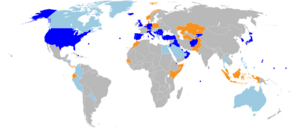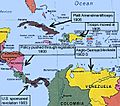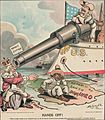American imperialism facts for kids
American imperialism describes how the United States has expanded its political, economic, and cultural influence beyond its own borders. This can involve different actions. For example, it might include taking over land by military force. It could also mean using strong economic power to get what it wants.
The idea of imperialism is often linked to the late 1800s. The U.S. government has never called itself an empire. However, some people use that word to describe its actions.
In the past, this influence included expanding into foreign lands. Many empires, like the British Empire, aimed to expand their territories. Modern imperialism started in the 1400s. This was when European countries explored and claimed lands in the New World.
American imperialism began in the 1890s. In 1896, the U.S. took control of the Hawaiian Islands. After the Spanish–American War, the U.S. also took over Puerto Rico, Guam, and the Philippines. In 1914, the U.S. finished building the important Panama Canal.
The Roosevelt Corollary was an addition to the Monroe Doctrine. It gave the U.S. more power in Latin America. This idea was the basis for President Roosevelt's Big Stick policy. Over time, the U.S. shifted from simply expanding its land. It became more focused on influencing world events.
The United States has also been accused of neocolonialism. This is a modern type of dominance. It uses economic power instead of military force.
Pros and Cons of American Imperialism
American imperialism has both advantages and disadvantages.
Some advantages include:
- Helping American businesses and trade.
- Stopping European countries from interfering in the Western Hemisphere.
- Increasing America's influence around the world.
However, American imperialism also has negative sides:
- Sometimes leading to violence and mistreatment of local people.
- Being very expensive.
- Using up resources from other countries.
- Using economic and political pressure to spread American values.
- Protecting American interests, sometimes at the expense of others.
Images for kids
-
1898 political cartoon: "Ten Thousand Miles From Tip to Tip" meaning the extension of U.S. domination (symbolized by a bald eagle) from Puerto Rico to the Philippines. The cartoon contrasts this with a map of the smaller United States 100 years earlier in 1798.
-
U.S. westward expansion–portions of each territory were granted statehood since the 18th century.
-
Caricature by Louis Dalrymple showing Uncle Sam lecturing four children labeled Philippines, Hawaii, Puerto Rico and Cuba, in front of children holding books labeled with various U.S. states. A black boy is washing windows, a Native American sits separate from the class, and a Chinese boy is outside the door. The caption reads: "School Begins. Uncle Sam (to his new class in Civilization): Now, children, you've got to learn these lessons whether you want to or not! But just take a look at the class ahead of you, and remember that, in a little while, you will feel as glad to be here as they are!"
-
One of the New York Journal's most infamous cartoons, depicting Philippine–American War General Jacob H. Smith's order "Kill Everyone over Ten," from the front page on May 5, 1902.
-
American troops marching in Vladivostok during the Allied intervention in the Russian Civil War, August 1918
-
Protest against the deployment of Pershing II missiles in Europe, The Hague, Netherlands, 1983
-
On the cover of Puck published on April 6, 1901, in the wake of gainful victory in the Spanish–American War, Columbia—the National personification of the U.S.—preens herself with an Easter bonnet in the form of a warship bearing the words "World Power" and the word "Expansion" on the smoke coming out of its stack.
-
1903 cartoon, "Go Away, Little Man, and Don't Bother Me", depicts President Roosevelt intimidating Colombia to acquire the Panama Canal Zone
-
In 1899, Uncle Sam balances his new possessions which are depicted as savage children. The figures are Puerto Rico, Hawaii, Cuba, Philippines and "Ladrone Island" (Guam, largest of the Mariana Islands, which were formerly known as the Ladrones Islands).
-
A U.S. soldier stands guard duty near a burning oil well in the Rumaila oil field, Iraq, April 2003
-
Naval Base Guam in the U.S. territory of Guam
-
Map of the United States and directly controlled territories at its greatest extent from 1898 to 1902, after the Spanish–American War
-
A map of Central America, showing the places affected by Theodore Roosevelt's Big Stick policy
-
McDonald's in Saint Petersburg, Russia
-
Political cartoon depicting Theodore Roosevelt using the Monroe Doctrine to keep European powers out of the Dominican Republic.
See also
 In Spanish: Imperialismo estadounidense para niños
In Spanish: Imperialismo estadounidense para niños





















